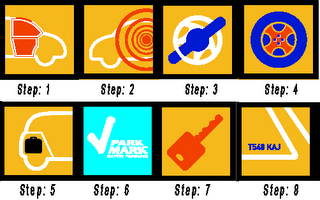|
The Metropolitan Police Department offers the following personal safety tips to help protect you when you are in your vehicle. - Always have your keys out and ready before leaving a building to approach your vehicle. Searching through a purse or briefcase after you've reached your car provides criminals an excellent opportunity to sneak up on you.
- Be especially alert when leaving stores or shopping malls for your vehicle. This is a time when criminals know you are carrying cash, checkbooks, credit cards, or other valuables.
- Look around and inside your vehicle before you get in. If you are concerned for any reason, simply walk past your car and call for help.
- Lock your door immediately upon entering the vehicle. Make this your first action-even before you put the key in the ignition. And lock your door every time you get into your car-even if you are going for only a short ride.
- Check your surroundings before getting out of your car. If something or someone strikes you as out of place or threatening, drive away. If it's dark, go to a well-lighted, heavily traveled area.
- Use a two-piece key ring with your car keys separate from your other important keys. Give parking valets or mechanics your car keys only. Supplying the entire set of keys creates an opportunity for duplicates to be made.
- Avoid stairwells in parking garages. Try walking down the auto ramp instead. As long as you watch for cars, the ramp can be much safer.
- Avoid talking on your cellular phone while you drive. Concentrate on your driving, not your conversation. If you have to make a call, pull over to the side of the road.
              
posted by transport blogs
@ 11:17 PM
permanent link | |
0
comments

posted by transport blogs
@ 11:01 PM
permanent link | |
0
comments

posted by transport blogs
@ 8:45 PM
permanent link | |
0
comments

They stop the amateur and slow down the professional.
Anti-theft devices are not foolproof, but they can stop the amateur and slow down the professional. The longer it takes to steal a car, the more attention the thief attracts, and the more likely the thief will look elsewhere. Anti-theft devices include those listed below.
- Kill Switch: The car will not start unless a hidden switch is activated. The switch prevents electrical current from reaching the coil or carburetor. Please check your warranty before installing one of these switches. Some warranties prohibit installation of these devices, and doing so nullify the warranty. In such cases, there is a possibility that a STARTER BYPASS SWITCH could be used without affecting the warranty.
- Alarm Systems: These systems contain a device that will activate a siren, lights, or horn if the car is tampered with. Consider a backup power source for the alarm, as professionals could deactivate the alarm if they get to the power source. Keys or code numbers to the alarm should never be given to parking lot attendants or valets. (Do not try to fool a thief with an alarm decal when no alarm exists.)
- Fuel Switch: This device stops the fuel supply.
- Armored Collar: This equipment consists of a metal shield that locks around the steering column and covers the ignition, the starter rods, and the steering wheel interlock rod.
- Locking Gas Cap
- Crook Lock: This lock is a long metal bar that has a hook on each end to lock the steering wheel to the brake pedal.
- Chain and Lock: These devices should be used to secure motorcycles and motorscooters.
- Keyless Entry System
Anti-theft devices may cost a few dollars to several hundred dollars. Many of those devices are now standard or optional equipment offered by auto manufacturers.
              
posted by transport blogs
@ 9:12 PM
permanent link | |
0
comments

posted by transport blogs
@ 8:29 PM
permanent link | |
0
comments

- Lock your car. Take your keys.
- Never hide a spare key on the vehicle.
- Roll up windows completely.
- Remove keys from ignition.
- Park in well-lighted areas.
- When parking in attended lots or parking garages, leave only the ignition key with the attendant.
- Park as close as possible to an open business.
- Do not leave valuables in sight to tempt a thief.
- Always park with the wheels turned toward the curb.
- Back your car into the driveway. If you drive forward into the driveway, a car thief could raise the hood to hot wire the car, and it would appear to the neighbors that you were just working on the car.
- If you have a garage, use it.
- Lock your garage door.
- When going out of town, if possible, remove the distributor cap or the coil wire.
- Never leave your car running while it is unattended.
If Your Car Is Stolen...
- Call police.
- Vehicle theft should be reported as soon as possible. However, before the vehicle can be listed as stolen, you must have your vehicle's license number and/or the vehicle identification number (sometimes called VIN).
- Stolen vehicles are sometimes used in the commission of other crimes.
- Quick action often results in recovery of your vehicle as well as prevention of another crime.
- If the criminal is apprehended, be willing to file charges.
- Testify in court.
Follow Up
- If you recover your own vehicle, you must not touch or move your vehicle in order to preserve possible evidence.
Identifying Your Car
- Etch Vehicle Identification Numbers on window glass trim.
- Engrave expensive accessories such as T-tops, radios, etc. with car's Vehicle Identification Number.
- Drop a business card into the door frame.
- If possible, retain copies of all vehicle paperwork at home in a safe place.
- It is not good practice to keep the original certificate of title in the vehicle. If the car is stolen, this title can be altered easily and/or your signature can be forged.
              
posted by transport blogs
@ 9:23 PM
permanent link | |
0
comments

Following the advice below will reduce your chance of being a victim of vehicle theft: Step : 1Secure the doors, windows, boot and sunroof every time you leave the car. Step: 2Get an electronic immobiliser professionally fitted by a member of the Vehicle Systems Installation Board (VSIB) if your car has not already got one. You might also consider getting an alarm fitted. But in each case make sure you buy a product that is either hatcham compliant or Sold Secure approved. Remember, some security devices may get you a discount on your insurance - check with your insurer. Step: 3If you do not have an electronic immobilizer fitted, use a mechanical immobiliser such as a steering wheel lock every time you leave your car. Again, make sure it is Thatcham compliant or Sold Secure approved. Mechanical immobilisers are a relatively inexpensive alternative to electronic immobilisers, but remember to use it every time you leave your car. Step: 4Fit locking wheel nuts, as wheels are often a target for car thieves. Wheel nuts are not expensive and are easy to fit.  Step: 5 Step: 5Never leave things on show in your car. If you have to leave briefcases and other items in your car, put them out of sight before you start your journey. step: 6If you have fitted satellite navigation equipment, as well as removing it also hide the cradle and wipe the suction pad mark from the windscreen. Try to look for a public car park that is part of the police approved 'Safer Parking Scheme' and displays the Park Mark® sign. step: 7With good security, particularly on newer cars, obtaining the keys may be the only way a thief can steal it. Always take good care of them. Hide a spare set away in your home and never leave them by the front door or a window. step: 8Have the car registration number etched onto all glass surfaces, including the headlamps, as this could help recover the car if it is stolen.
              
posted by transport blogs
@ 10:37 PM
permanent link | |
0
comments

Theft of automobiles and of valuables left inside automobiles can usually be prevented by following these simple precautions:
- Never leave your vehicle with the engine running or Never leave keys in the ignition, even for a moment.
- Always lock all doors and windows of your vehicle after entering and exiting.
- If possible install loud alarm systems in your car, so that thieves will be discouraged even if they manage to break into your car.
- Never leave an identification tag on your key ring. Thieves may use it to locate your home or car.
- Never hide a spare key in the car, thieves know where to look for it.
- Never leave personal identification or valuables in the vehicle. Lock all valuables in the trunk. Don't tempt thieves by leaving packages, cameras, or purses on the seat.
- Mount tape decks and CD players inconspicuously. If you have a portable phone in the car, use mountings that allow you to take the equipment with you or at least store in the trunk for safekeeping.
- Park in well-lit, busy areas for your own safety as well as your car's.
- Engrave removable accessories such as stereo's, CB equipment, telephones etc.
- Consider buying smooth, non-flared locking buttons for your car doors.
- A variety of other devises are available to safeguard your vehicle, i.e. hood locks, alarms, and kill switches to prevent hot wiring.
In case your vehicle is stolen
- Report the theft to the nearest police station.
- Inform your insurance company
              
posted by transport blogs
@ 9:14 PM
permanent link | |
0
comments

|
![]()
![]()














